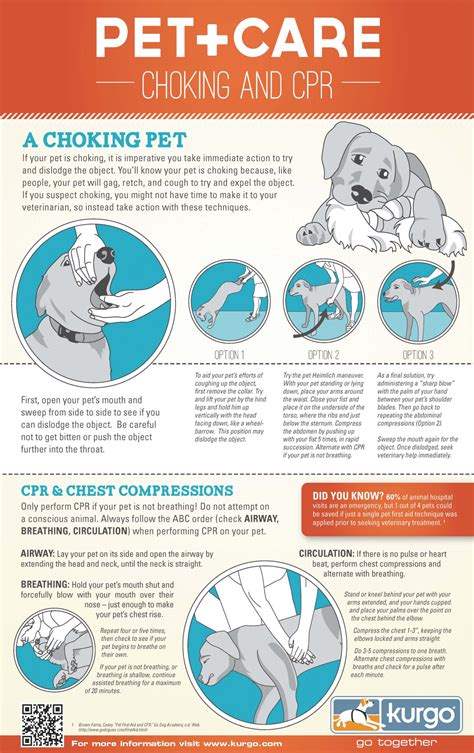Introduction

Pets are cherished members of our families, and their well-being is paramount. Therefore, it’s essential to ensure that we’re equipped with the knowledge and skills to provide care in case of emergencies. This comprehensive guide will empower you with the necessary information on pet first aid and CPR to safeguard your furry friend’s health and happiness.
Essential First Aid Knowledge for Pets
-
Wounds and Bleeding: Stop bleeding by applying direct pressure with a clean cloth or bandage. If the wound is deep or extensive, seek veterinary attention immediately.
-
Burns and Scalds: Cool the burn with cold water for 10-15 minutes. Do not apply ice directly to the affected area. Cover the burn with a loose bandage and seek veterinary attention.
-
Poisoning: If your pet ingests a poisonous substance, contact your veterinarian or the ASPCA’s Animal Poison Control Center immediately. Do not induce vomiting unless instructed to do so by a medical professional.
-
Seizures: Remain calm and observe the seizure’s duration and intensity. Protect your pet from potential hazards and monitor their breathing. Do not restrain them or put anything in their mouth.
-
Heatstroke: Move your pet to a cool area, apply cold water or ice packs to their body, and offer them water. Seek veterinary attention promptly.
CPR for Dogs and Cats
-
Check for Responsiveness: Gently shake your pet and call their name. If there is no response, proceed to check for breathing and circulation.
-
Check for Breathing: Place your ear close to your pet’s nose and mouth to listen and feel for breathing. If they are not breathing, start CPR immediately.
-
Check for Circulation: Feel for a pulse on the inside of your pet’s thigh. If there is no pulse, start CPR immediately.
-
Chest Compressions: For dogs, place your hands on their chest, just behind the elbows. For cats, place one hand on the chest, behind the elbow, and the other on the back, over the spine. Push down firmly and release, at a rate of 100-120 compressions per minute.
-
Rescue Breathing: Pinch your pet’s nose closed and give them two gentle breaths into their mouth. Repeat every 2-3 seconds until they start breathing on their own.
Training and Certification
Pet first aid and CPR classes are widely available through veterinary clinics, pet stores, and animal welfare organizations. These classes provide hands-on training and certification, ensuring that you are confident in providing emergency care for your pet.
Emergency Kits
Prepare an emergency kit for your pet, including:
- First aid kit
- CPR mask
- Thermometer
- Pet carrier
- Leash
- Medication (if prescribed by a veterinarian)
- Contact information for your veterinarian
When to Seek Professional Help
While pet first aid and CPR can help stabilize your pet in an emergency, it is crucial to seek veterinary attention for any serious injuries or illnesses. Signs that require professional medical care include:
- Persistent bleeding
- Open wounds
- Severe burns or scalds
- Seizures lasting more than 5 minutes
- Heatstroke
- Difficulty breathing
- No pulse or heartbeat
- Loss of consciousness
FAQs
-
What is the most common pet emergency?
– Gastrointestinal distress (e.g., vomiting, diarrhea) -
How often should I check my pet’s first aid kit?
– Every 6-12 months to ensure its contents are fresh and complete. -
What is the legal responsibility of pet owners during an emergency?
– To provide reasonable care and treatment for their pets. -
How can I improve my pet’s chances of survival in an emergency?
– Stay calm and act quickly.
– Know how to perform pet first aid and CPR.
– Have an emergency kit prepared.
– Maintain open communication with your veterinarian.
Future Trends and Innovations
The future of pet first aid and CPR is promising, with advancements in technology and research expected to enhance the care we provide for our beloved companions. Some trending areas include:
- Telemedicine for veterinary emergencies
- Remote pet monitoring devices
- AI-powered diagnostic tools
- Personalized treatment plans
Conclusion
Pet first aid and CPR are essential skills that all pet owners should possess. By equipping ourselves with the necessary knowledge and skills, we can provide prompt and appropriate care in case of emergencies, ensuring the well-being of our furry friends. Remember to regularly check your pet’s first aid kit, stay updated on the latest advancements in pet care, and never hesitate to seek veterinary attention when needed.





















